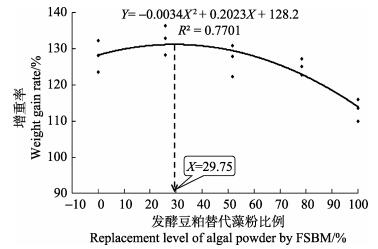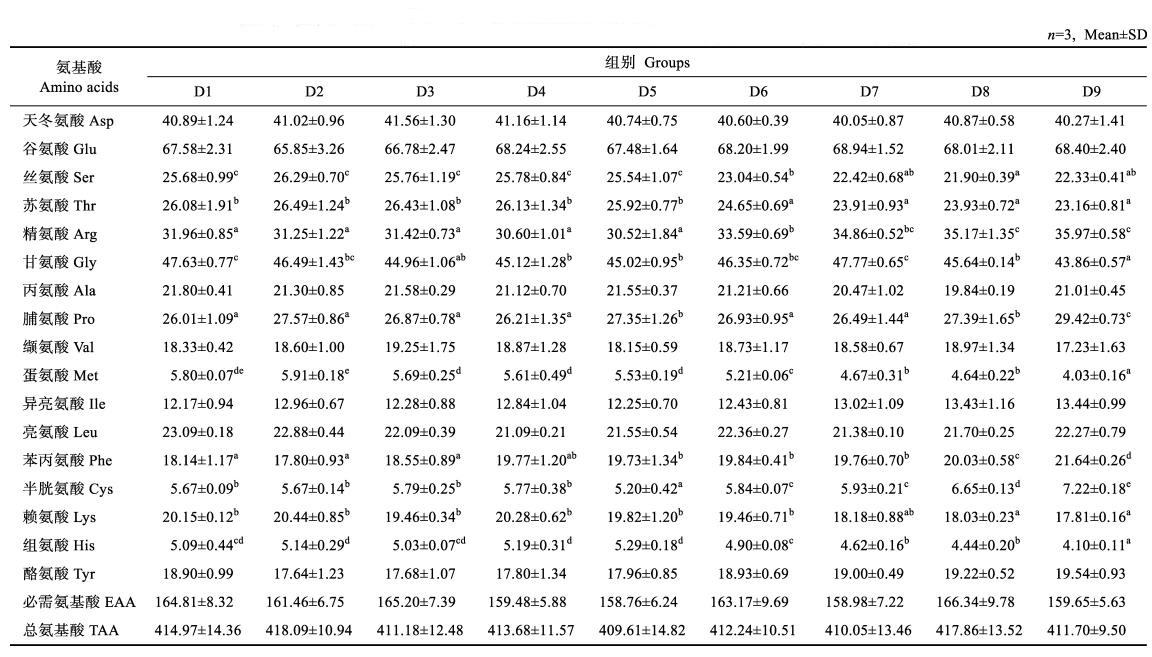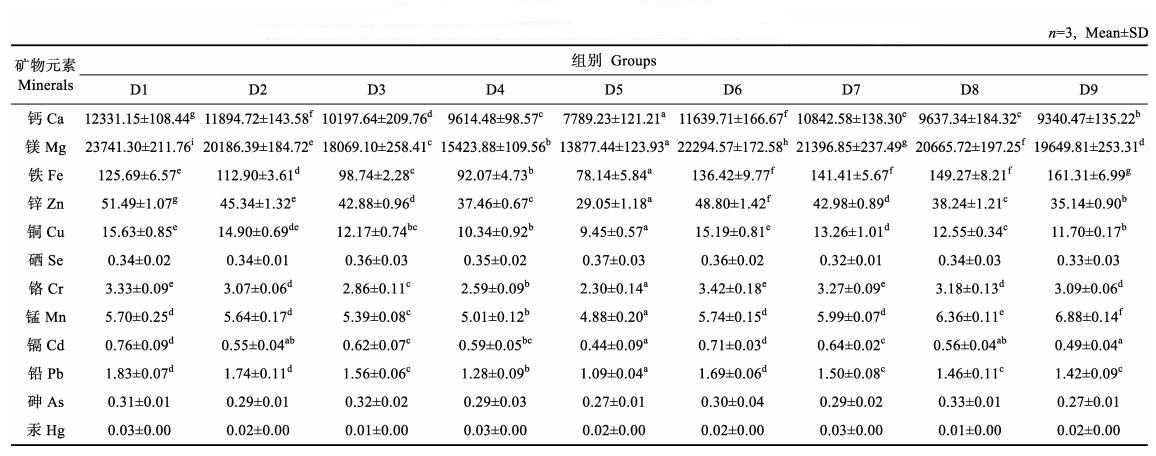豆粕具有来源稳定、价格合理、消化利用率高等优点,是替代鱼粉的最佳植物蛋白原料。但由于存在抗营养因子等,限制了其在高档水产饲料中的应用。利用现代生物工程技术,将豆粕发酵,可降低大豆凝集素、胰蛋白酶抑制因子和致甲状腺肿素的含量(张丽靖等, 2008),提高粗蛋白、粗脂肪和磷的含量(马文强等, 2008),同时可将大分子蛋白质降解为小分子肽(Hong et al, 2004;欧阳亮等, 2008)。此外,豆粕发酵后,微量元素及维生素含量有所提高(Kim et al, 1999),且具有一定的芳香味和鲜味,可提高动物对其的消化利用率。发酵豆粕(Fermented soybean meal, FSBM)可替代牙鲆(Paralichthys olivaceus) (Md et al, 2012)、黑鲷(Acanthopagrus schlegelii)(Zhou et al, 2011)、石斑鱼(Epinephelus coioides) (Luo et al, 2004)等饲料中的部分鱼粉。
刺参(Apostichopus japonicus)属于棘皮动物门(Echinodermata)、海参纲(Holothroidea),是我国名贵海珍品之一。近年来,随着养殖规模的扩大,饲料中主要原料藻粉出现了短缺。与鼠尾藻(Sargassum thunbergii)、马尾藻(Sargassum muticum)、海带(Laminaria japonica)(Xia et al, 2012a)、石莼(Ulva lactuca L)(Xia et al, 2012b)、裂壶藻(Schizochytrium) (黄亮华等, 2014)等海洋藻类相比,陆生植物蛋白原料具有来源稳定、对环境影响小等优点。目前,关于陆生植物蛋白在刺参配合饲料中的报道见于玉米蛋白(王吉桥等, 2007)、豆粕(樊月居等, 2010)和甘薯(赵斌等, 2016)。因此,本实验以发酵豆粕分别替代配合饲料中的藻粉及藻粉鱼粉混合物,研究其对刺参生长及体组成的影响,以期为发酵豆粕在刺参配合饲料中的应用提供参考。
1 材料与方法 1.1 实验饲料的配方及制作以鱼粉和藻粉为蛋白源,设计粗蛋白含量为22%左右的基础饲料配方,分别以0、5%、10%、15%、19.35%的发酵豆粕等蛋白替代基础饲料中的藻粉,以7.6%、15.2%、22.8%、30.4%的发酵豆粕等蛋白替代基础饲料中鱼粉藻粉混合物(2:15),配制9组等氮实验饲料,记为D1–D9组,其中,D1为对照组,D2–D5为替代藻粉组,D6–D9为替代混合物组(表 1)。实验中所用主要蛋白原料及等蛋白平衡后原料氨基酸组成见表 2。固体原料按比例称重后粉碎过200目标准筛,加入鱼油及适量的蒸馏水混匀,用饲料制粒机制成直径为0.3 cm的颗粒,60℃烘干,用小型粉碎机粉碎,筛选60–80目之间的颗粒备用。
|
|
表 1 实验饲料配方及其基本成分(%) Table 1 The formula and proximate composition of experimental diets (%) |
|
|
表 2 实验所用主要蛋白原料的氨基酸组成(mg/g) Table 2 Composition of amino acids of main protein ingredients in the trials (mg/g) |
养殖实验在山东省海洋资源与环境研究院东营实验基地循环水养殖系统内进行,实验用刺参购自山东蓬莱安源水产有限公司。实验采用循环微流水养殖,水流速约为100 ml/min。深蓝色圆柱形养殖水桶(Ф84 cm× 80 cm)内放置刺参养殖筐1个,内嵌波纹板20张,控制水深为50 cm。实验开始前,2000头规格整齐、体质健壮的刺参放养于系统中,期间投喂对照组饲料,使其适应养殖环境和实验饲料。21 d后挑选体重约为17.7 g的刺参810头,平均放养于27个养殖桶中,每桶30头。每种实验饲料投喂3桶,每日投喂1次(16:00),投喂时将饲料与海泥(1:1) 混合均匀,加水湿润后泼洒投喂,投喂量为刺参体重的4%,并根据摄食状况随时调整。投喂时停气,待饲料颗粒沉到水底或波纹板上后,恢复充气。每隔2 d用虹吸法将粪便及残饵吸出,并补充1/3新水。实验期间,水温为17–22℃,DO>6 mg/L,NH4+-N及NO–-N均小于0.1 mg/L,pH为7.2–7.5,养殖周期为70 d。
1.3 样品采集与参数计算养殖实验结束后,禁食48 h,放掉桶内水后收集实验刺参,计数,在空气中放置30 s后称重。每桶随机挑选15头刺参,置于洁净的白瓷盘中,待其恢复自然体长,测量体长、体重后解剖,分离消化道,分别测量体壁重、肠道重和肠道长度。将体壁置于–20℃保存待测。
增重量(Weight gain, WG, g)=Wf–Wi;
增重率(Weight gain rate, WGR, %)=WG/Wi×100;
特定生长率(Specific growth rate, SGR, %/d)= (lnWf–lnwi)/d×100;
存活率(Survival rate, SR, %)=Nf/Ni×100;
脏壁比(Ratio of visceral weight to body wall weight, VBR, %)=Wv/Wb×100;
肠壁比(Ratio of intestine weight to body wall weight, IBR, %)=Win/Wb×100;
肠长比(Ratio of intestine length to body length, IBL)=Li/Lb;
式中,Wf为末体重(g),Wi为初始体重(g),d为养殖天数,Nf为存活刺参数量,Ni为实验初始刺参数量,Wv为内脏重量(g),Wb为体壁重量(g),Win为肠道重量(g),Li为肠道长度(cm),Lb为体长(cm)。
1.4 样品测定饲料或样本中水分测定采用105℃恒重法,粗蛋白测定采用杜马斯燃烧法(Leco, FP-528, 美国),粗脂肪测定采用索氏抽提法,粗灰分测定采用550℃灰化法,能量测定采用燃烧法(Parr, 6100, 美国);样品酸水解后,用全自动氨基酸分析仪(Hitachi, L-8900, 日本)测定氨基酸含量;体壁浓硝酸微波消解后用电感耦合等离子质谱仪(ICP-MS, Agilent 7700, 美国)测定Ca、Fe、Mg、Zn、Cu、Cr含量,用原子荧光形态分析仪(北京吉天, SA-10, 中国)测定Se、Cd、Pb、As、Hg含量。
1.5 数据处理实验所得数据采用Excel 2007及SPSS 11.0 One-way ANOVA处理,结果以平均值±标准差(Mean± SD)表示,差异显著(P < 0.05) 时用Duncan’s检验进行多重比较分析,分别采用Statistical analysis system 9.2 (SAS Institute Inc. USA) REG与NLIN对增重率与替代比例之间的关系进行回归分析。
2 结果 2.1 发酵豆粕对刺参生长及形体指数的影响发酵豆粕替代藻粉后,实验刺参的增重率、特定生长率、脏壁比、肠壁比均呈先升后降的趋势,在D2组达到最高,显著高于D4及D5组(P < 0.05);随替代混合物比例的升高,D8、D9组增重率及特定生长率显著低于前3组(P < 0.05),前3组之间无显著差异(P > 0.05)。发酵豆粕替代藻粉或混合物对刺参的成活率无显著影响(P > 0.05)(表 3)。以增重率为评价指标,经SAS REG回归分析,发酵豆粕替代藻粉的适宜比例为29.75% (图 1);经SAS NLIN回归分析,发酵豆粕替代刺参配合饲料中46.46%的鱼粉藻粉混合物而不影响其生长(图 2)。
|
|
表 3 发酵豆粕对刺参生长及形体指标的影响 Table 3 Effects of dietary FSBM on the growth performance and figure indices of A. japonicus |

|
图 1 发酵豆粕替代藻粉对刺参增重率的影响 Figure 1 Effects of the replacement level of algal powder by FSBM on the WGR of juvenile A. japonicus |

|
图 2 发酵豆粕替代鱼粉藻粉混合物对刺参增重率的影响 Figure 2 Effects of the replacement level of fishmeal and algal powder by FSBM on the WGR of juvenile A. japonicus |
发酵豆粕替代藻粉后,刺参体壁中粗脂肪含量显著降低(P < 0.05),水分、粗蛋白和粗灰分含量无显著变化(P > 0.05);发酵豆粕替代混合物后,刺参体壁粗灰分的含量显著降低(P < 0.05),而水分、粗蛋白及粗脂肪含量无显著变化(P > 0.05) (表 4)。
|
|
表 4 发酵豆粕对刺参体壁基本成分的影响(%) Table 4 Effects of dietary FSBM on proximate co, position of bpdy wall of A. japonicus(%) |
发酵豆粕替代藻粉后,降低了刺参体壁中甘氨酸、蛋氨酸及半胱氨酸的含量(P < 0.05),提高了苯丙氨酸和组氨酸的含量(P < 0.05);发酵豆粕替代混合物后,降低了刺参体壁中丝氨酸、苏氨酸、甘氨酸、蛋氨酸、赖氨酸及组氨酸含量(P < 0.05),提高了精氨酸、脯氨酸、苯丙氨酸及半胱氨酸含量(P < 0.05);发酵豆粕替代藻粉或混合物,对体壁中天冬氨酸、谷氨酸、丙氨酸、缬氨酸、异亮氨酸、亮氨酸、酪氨酸、必需氨基酸及总氨基酸含量无显著影响(P > 0.05)(表 5)。
|
|
表 5 发酵豆粕对刺参体壁氨基酸含量的影响(mg/g) Table 5 Effects of dietary FSBM on amino acid of body wall of A. japonicus(mg/g) |
发酵豆粕替代藻粉后,刺参体壁中Ca、Mg、Fe、Zn、Cu、Cr、Mn及Pb的含量降低(P < 0.05);发酵豆粕替代混合物后,刺参体壁中Ca、Mg、Zn、Cu、Cr及Pb含量显著降低(P < 0.05),Fe及Mn的含量显著升高(P < 0.05)。发酵豆粕替代藻粉或混合物对Se、Cd、As及Hg含量影响不显著(P > 0.05)(表 6)。
|
|
表 6 发酵豆粕对刺参体壁矿物元素含量的影响(mg/kg) Table 6 Effects of dietary FSBM on mineral contents of body wall of A. japonicus(mg/kg) |
本研究结果显示,发酵豆粕可以部分替代刺参配合饲料中的藻粉或鱼粉藻粉混合物。发酵豆粕替代藻粉后,实验刺参的增重率呈先升后降的趋势,这与几种蛋白原料中氨基酸模式互补有关(Md et al, 2012),随着替代量的升高,导致饲料中某些氨基酸的缺乏,破坏了氨基酸平衡模式(Deng et al, 2006),且可能由于发酵豆粕中抗营养因子去除不彻底(Uyan et al, 2006),导致刺参生长速度下降。随着替代量的升高,实验刺参的肠壁比及肠长比显著降低,说明相较于发酵豆粕,藻粉更适合刺参肠道的发育。发酵豆粕替代46%的鱼粉藻粉混合物不会影响实验刺参的生长,过高则抑制其生长,这与在其他水生动物中的研究结果一致(Luo et al, 2004; Yuan et al, 2013; Azarm et al, 2014),可能与发酵豆粕中蛋氨酸缺乏有关(Gallagher et al, 1994;杨耐德等, 2008)。此外,随着发酵豆粕含量的升高,饲料粗灰分含量显著升高,这可能是造成刺参生长性能下降的另一个原因,但需要进一步的研究。
3.2 发酵豆粕对刺参体壁组成的影响随着饲料中发酵豆粕含量的升高,实验刺参体壁中水分及粗蛋白含量变化不显著,粗脂肪含量显著降低,与凡纳滨对虾(Litopenaeus vannamei)中的结果一致(杨耐德等, 2008)。Ye等(2011) 研究发现,饲料中豆粕添加过量,可导致牙鲆机体脂肪代谢紊乱而造成脂肪蓄积降低。鱼类生长性能下降会导致机体中粗灰分含量上升(段培昌等, 2009;黄云等, 2012)。本研究中,随着饲料中发酵豆粕含量的升高,刺参体壁中粗灰分呈下降趋势。发酵豆粕替代藻粉后,7种矿物元素含量显著降低;发酵豆粕替代鱼粉藻粉混合物后,5种矿物元素含量显著降低,仅2种显著升高,且降低幅度远大于升高幅度。豆粕发酵后呈酸性,可以促进铁的吸收(Pandey et al, 2008)。在对鸡(Gallus domesticus)的研究中表明,Fe2+、Mn2+、Cu2+、Zn2+等在肠道中通过铁诱导型二价阳离子转运蛋白1(DMT1) 进行吸收(李晓丽等, 2013),因而Fe2+会抑制其他二价阳离子的吸收利用(Rodriguez-Matas et al, 1998)。两个实验中,发酵豆粕最高添加量分别为18.0%和30.4%,这可能是导致矿物元素沉积差异的原因。与乳山刺参相比,本实验刺参体壁矿物元素中的Ca、Mg含量显著上升,而Fe、Cu、Mn、Zn、Cr及4种重金属元素含量显著降低,由于二者之间不存在显著的地域差异性(刘小芳等, 2014)1),因此,导致这种差异的原因更偏重于环境及饵料,具体原因有待于进一步研究。本研究中所测的4种重金属元素有降低趋势,但只有Cr和Pb含量下降达到显著水平,这与饲料中藻粉含量的降低有关(张永亮等, 2011)。本研究所测得的刺参体壁中重金属含量均低于相关食品卫生标准限量。
1) Liu XF. Study of regional differences in nutrient compositions and bioactivities of phospholipids in sea cucumber (Apostichopus japonicus). Doctoral Dissertation of Ocean University of China, 2014, 41 [刘小芳.刺参营养成分的地域性差异分析及其磷脂的活性研究.中国海洋大学博士研究生学位论文, 2014, 41]
饲料中发酵豆粕含量虽然没有影响实验刺参体壁粗蛋白含量,但影响其氨基酸含量。本研究所测得的17种氨基酸中有10种含量发生了显著变化,其中6种为必需氨基酸(Thr, Arg, Met, Phe, Lys, His),且体壁中氨基酸含量与饲料中氨基酸含量不存在相关性,这与在银鲳(Pampus argenteus) (彭士明等, 2012)、罗氏沼虾(Macrobrachium rosenbergii)(程媛媛等, 2009)和凡纳滨对虾(严晶等, 2012) 中的研究结果一致,表明动物是按照一定的氨基酸模式利用饲料中的蛋白质(Mai et al, 2006),氨基酸不平衡会造成饲料蛋白质的浪费。本研究中所测得9种必需氨基酸含量与其他研究类似(Deng et al, 2006;王哲平等, 2012),以精氨酸含量最高,而真鲷(Pagrosomus major)(唐宏刚等, 2008)2)和牙鲆(Kim et al, 2000)等海水鱼类肌肉中含量最高的必需氨基酸为赖氨酸,这既体现了种属上的差异,也表明了需求的不同(王际英等, 2015)。
2) Tang HG. Effects of fish protein hydrolysate on growth, metabolism, flesh quality, immunity and antioxidation in large yellow croaker. Doctoral Dissertation of Zhejiang University, 2008, 26 [唐宏刚.鱼蛋白水解物对大黄鱼生长代谢、肌肉品质、免疫及抗氧化性能的影响.浙江大学博士研究生学位论文, 2008, 26]
4 结论本实验条件下,发酵豆粕替代藻粉的最佳比例为29.75%,而发酵豆粕最高可替代46.46%的鱼粉藻粉混合物而不影响实验刺参的生长。本研究所测得4种重金属含量均低于国家相关卫生标准限量。
| Azarm HM, Lee SM. Effects of partial substitution of dietary fish meal by fermented soybean meal on growth performance, amino acid and biochemical parameters of juvenile black sea bream Acanthopagrus schlegelii. Aquaculture Research, 2014, 45(6): 994-1003 DOI:10.1111/are.2014.45.issue-6 | |
| Cheng YY, Zhou HQ, Hua XM, et al. Effects of partial replacement of dietary fish meal by corn gluten meal on growth, nutrient ingredients and amino acid retention in muscle of Macrobrachium rosenbergii. Journal of Fishery Sciences of China, 2009, 16(4): 572-579 [程媛媛, 周洪琪, 华雪铭, 等. 玉米蛋白粉部分替代鱼粉对罗氏沼虾生长、氨基酸沉积率和肌肉营养成分的影响. 中国水产科学, 2009, 16(4): 572-579] | |
| Deng JM, Mai KS, Ai QH, et al. Effects of replacing fish meal with soy protein concentrate on feed intake and growth of juvenile Japanese flounder, Paralichthys olivaceus. Aquaculture, 2006, 258(1-4): 503-513 DOI:10.1016/j.aquaculture.2006.04.004 | |
| Duan PC, Zhang LM, Wang JY, et al. The preliminary study on the effects of new protein sources replacing dietary fishmeal on growth performance, body composition and hematology of juvenile starry flounder (Platichthys stellatus). Journal of Fisheries of China, 2009, 33(5): 797-804 [段培昌, 张利民, 王际英, 等. 新型蛋白源替代鱼粉对星斑川鲽幼鱼生长、体成分和血液学指标的影响. 水产学报, 2009, 33(5): 797-804] | |
| Fan YJ, Li XD, Luo Z, et al. Effects of replacement of dietary fish meal by soybean meal on growth, body composition and digestive enzyme activities in sea cucumber Apostichopus japonicus juveniles. Journal of Dalian Fisheries University, 2010, 25(1): 71-75 [樊月居, 李晓东, 罗智, 等. 饲料中用豆粕替代鱼粉对仿刺参幼参生长、体成分及消化酶活性的影响. 大连水产学院学报, 2010, 25(1): 71-75] | |
| Gallagher ML. The use of soybean meal as a replacement for fish meal in diets for hybrid striped bass (Morone saxatilis×Mchrysops) . Aquaculture, 1994, 126(1-2): 119-127 DOI:10.1016/0044-8486(94)90253-4 | |
| Hong KJ, Lee CH, Kim SW. Aspergillus oryzae GB-107 fermentation improve nutritional quality of soybeans and feed soybean meal. Journal of Medicinal Food, 2004, 7(4): 430-434 DOI:10.1089/jmf.2004.7.430 | |
| Huang LH, Li HY, Li B, et al. Effects of dietary Schizochytrium limacinum on the growth, immunity and digestion enzyme activity of sea cucumber Apostichopus japonicas. Progress in Fishery Sciences, 2014, 35(3): 91-97 DOI:10.11758/yykxjz.20140313 [黄亮华, 李浩洋, 李彬, 等. 裂壶藻对刺参生长、免疫及消化酶的影响. 渔业科学进展, 2014, 35(3): 91-97] | |
| Huang Y, Hu Y, Xiao TY, et al. Influence of dietary canola meal levels on growth and biochemical indices in juvenile Mylopharvngodon piceus. Acta Hydrobiological Sinica, 2012, 36(1): 41-48 [黄云, 胡毅, 肖调义, 等. 双低菜粕替代豆粕对青鱼幼鱼生长及生理生化指标的影响. 水生生物学报, 2012, 36(1): 41-48] | |
| Kim BN, Yang JL, Song YS. Physiological functions of chongkukjang. Food Industry and Nutrition, 1999, 11061106(4): 40-46 | |
| Kim JD, Lall SPP. Amino acid composition of whole body tissue of Atlantic halibut (Hippoglossus hippoglossus), yellowtail flounder (Pleuronectes ferruginea) and Japanese flounder (Paralichthys olivaceus). Aquaculture, 2000, 187(3-4): 367-373 DOI:10.1016/S0044-8486(00)00322-7 | |
| Li XL, Lu L, Xie JJ, et al. Characteristics, affecting factors and molecular mechanisms of manganese absorption in chicken intestine. Chinese Journal of Animal Nutrition, 2013, 25(3): 486-493 [李晓丽, 吕林, 解竞静, 等. 锰在鸡肠道中吸收的特点、影响因素及分子机制. 动物营养学报, 2013, 25(3): 486-493] | |
| Luo Z, Liu YJ, Mai KS, et al. Partial replacement of fish meal by soybean protein in diets for grouper Epinephelus coioides juveniles. Journal of Fisheries of China, 2004, 28(2): 175-181 | |
| Ma WQ, Feng J, Liu X. Nutritional characteristics of microbe fermented soybean meal. Journal of the Chinese Cereals and Oil Association, 2008, 23(1): 121-124 [马文强, 冯杰, 刘欣. 微生物发酵豆粕营养特性研究. 中国粮油学报, 2008, 23(1): 121-124] | |
| Mai KS, Wan JL, Ai QH, et al. Dietary methionine requirement of large yellow croaker, Pseudosciaena crocea R. Aquaculture, 2006, 253(1-4): 546-572 | |
| Md AK, Shunsuke K, Manabu I, et al. Can fermented soybean meal and squid by-product blend be used as fishmeal replacements for Japanese flounder (Paralichthys olivaceus)?. Aquaculture Research, 2012, 43(10): 1427-1438 DOI:10.1111/are.2012.43.issue-10 | |
| Ouyang L, Li L, Cai YF. Study of anti-nutrition protein in soybean fermented by SDS-PAGE analysis. Feed Industry, 2008, 29(21): 43-45 DOI:10.3969/j.issn.1001-991X.2008.21.014 [欧阳亮, 李亮, 蔡源锋. 垂直型SDS-PAGE分析发酵豆粕中蛋白类抗营养因子的研究. 饲料工业, 2008, 29(21): 43-45] | |
| Pandey A, Satoh S. Effects of organic acids on growth and phosphorus utilization in rainbow trout Oncorhychus mykiss. Fisheries Science, 2008, 74(4): 867-874 DOI:10.1111/fis.2008.74.issue-4 | |
| Peng SM, Shi ZH, Sun P, et al. Effects of diet composition on growth rate, muscle amino acid and fatty acid composition of juvenile silver pomfret (Pampus argenteus). Marine Fisheries, 2012, 34(1): 51-56 [彭士明, 施兆鸿, 孙鹏, 等. 饲料组成对银鲳幼鱼生长率及肌肉氨基酸、脂肪酸组成的影响. 海洋渔业, 2012, 34(1): 51-56] | |
| Rodriguez-Matas MC, Lisbona F, Gomez-Ayala AEI, et al. Influence of nutritional iron deficiency development on some aspects of iron, copper and zinc metabolism. Laboratory Animals, 1998, 32(3): 298-306 DOI:10.1258/002367798780559248 | |
| Uyan O, Koshio S, Teshima S, et al. Growth and phosphorus loading by partially replacing fishmeal with tuna muscle by-product powder in the diet of juvenile Japanese flounder, Paralichthys olivaceus. Aquaculture, 2006, 257(1-4): 437-445 DOI:10.1016/j.aquaculture.2006.02.060 | |
| Wang JQ, Jiang XH, Zhao LJ, et al. Effects of dietary protein source on growth in juvenile sea cucumber (Apostichopus japonicus). Feed Review, 2007, 11061106(19): 9-13 [王吉桥, 蒋湘辉, 赵丽娟, 等. 不同饲料蛋白源对仿刺参幼参生长的影响. 饲料博览, 2007, 11061106(19): 9-13] | |
| Wang JY, Li BS, Zhang DR, et al. Effects of dietary arginine on growth performance, immune responses and digestive enzyme of juvenile sea cucumber Apostichopus japonicus Selenka. Journal of Fisheries of China, 2015, 39(3): 410-420 [王际英, 李宝山, 张德瑞, 等. 饲料中添加精氨酸对仿刺参幼参生长、免疫能力及消化酶活力的影响. 水产学报, 2015, 39(3): 410-420] | |
| Wang JY, Song ZD, Li PY, et al. Effects of dietary galactomannan oligosaccharides on growth, digestion, body wall nutritional composition and immunity of juvenile sea cucumber (Apostichopus japonicus). Journal of Fishery Sciences of China, 2014, 21(2): 310-319 [王际英, 宋志东, 李培玉, 等. 饲料添加半乳甘露寡糖对刺参幼参生长、体壁营养组成及免疫力的影响. 中国水产科学, 2014, 21(2): 310-319] | |
| Wang ZP, Liu Q, Cao R, et al. Comparative analysis of nutritive composition between wild and cultured sea cucumber Apostichopus japonicus. South China Fisheries Science, 2012, 8(2): 64-70 [王哲平, 刘淇, 曹荣, 等. 野生与养殖刺参营养成分的比较分析. 南方水产科学, 2012, 8(2): 64-70] | |
| Xia SD, Zhao P, Chen K, et al. Feeding preferences of the sea cucumber Apostichopus japonicus (Selenka) on various seaweed diets. Aquaculture, 2012a: 344-349-205-209 | |
| Xia SD, Yang HS, Li Y, et al. Effects of different seaweed diets on growth, digestibility, and ammonia-nitrogen production of the sea cucumber Apostichopus japonicus (Selenka). Aquaculture, 2012b: 338-341-304-308 | |
| Yan J, Cao JM, Wang GX, et al. Effects of replacement of fish meal with housefly maggot meal on muscle nutritional composition, amino acids, and inosine monophosphate content in juvenile Litopenaeus vannamei. Journal of Fishery Sciences of China, 2012, 19(2): 265-274 [严晶, 曹俊明, 王国霞, 等. 家蝇蛆粉替代鱼粉对凡纳滨对虾肌肉营养成分、氨基酸和肌苷酸含量的影响. 中国水产科学, 2012, 19(2): 265-274] | |
| Yang ND, Fu GC. Research on replacement fish meal by fermented soybean meal in Litopenaeus vannamei feed. Feed Industry, 2008, 29(10): 24-26 DOI:10.3969/j.issn.1001-991X.2008.10.008 [杨耐德, 符广才. 凡纳滨对虾饲料中发酵豆粕替代鱼粉的研究. 饲料工业, 2008, 29(10): 24-26] | |
| Ye J, Wang Z, Wang K. Effect of partial fish meal replacement by soybean meal on the growth performance and biochemical indices of juvenile Japanese flounder (Paralichthys olivaceus). Aquaculture International, 2011, 19(1): 143-153 DOI:10.1007/s10499-010-9348-1 | |
| Yuan YC, Lin YC, Yang HJ, et al. Evaluation of fermented soybean meal in the practical diets for juvenile Chinese sucker, Myxocyprinus asiaticus. Aquaculture Nutrition, 2013: 74-83 | |
| Zhang LJ, Qi LL, Yang Y. Effect of fermented Bacillus natto on urease activity of soymeal. Soybean Science, 2008, 27(4): 670-672 [张丽靖, 齐莉莉, 杨郁. 纳豆菌对豆粕脲酶活性的影响. 大豆科学, 2008, 27(4): 670-672] | |
| Zhang YL, Zhang HJ, Xie SB, et al. Research advance in adsorption of heavy metals by algae. Uranium Mining and Metallurgy, 2009, 28(1): 31-37 [张永亮, 张浩江, 谢水波, 等. 藻类吸附重金属的研究进展. 铀矿冶, 2009, 28(1): 31-37] | |
| Zhao B, Hu W, Li CL, et al. The nutritional effects of two feedstuffs from sweet potato on feeding and growth of sea cucumber Apostichopus japonicus. Progress in Fishery Sciences, 2016, 37(1): 80-86 DOI:10.11758/yykxjz.20150514001 [赵斌, 胡炜, 李成林, 等. 两种甘薯饲料原料的营养成分及其对仿刺参(Apostichopus japonicus)摄食与生长的影响. 渔业科学进展, 2016, 37(1): 80-86] | |
| Zhou F, Song WX, Shao QJ, et al. Partial replacement of fish meal by fermented soybean meal in diets for black sea bream, Acanthopagrus schlegelii, juveniles. Journal of World Aquaculture Society, 2011, 42(2): 184-197 DOI:10.1111/jwas.2011.42.issue-2 |







